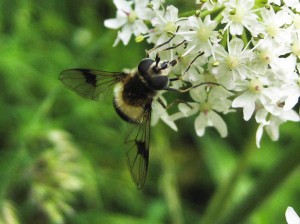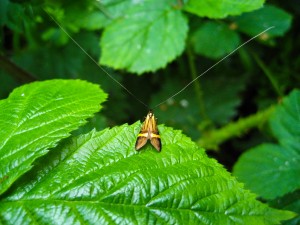For a while I have been thinking about getting a moth trap, but something about it just seems a bit mean. Moths don’t live for long and to keep them trapped for a night, especially when there are so many other hazards awaiting them just seems, well, wrong. However, this doesn’t mean that I don’t get to see some of the UK’s most spectacular moths.
Moths seem generally unloved and forgotten about by the general public, especially when compared to their butterfly cousins (I say cousins, but really there is little difference between a moth and a butterfly). I think that butterfly PR is helped by the fact that they fly during the day, whereas there are only a relatively small number of day flying moths. Or perhaps it is because there are only around 60 UK butterflies (and some of those are seen in only a few places in the British Isles) whereas there are a few hundred moth types – much more confusing.
It’s really only in the last few months that I have taken much of an interest in moths – the aforementioned butterflies taking my attention for the reasons outlined. However, the door to my office block seems to have been attracting some particularly distinctive moths in the last month – so distinctive that even a complete beginner like myself has been able to identify them with the help of a book and the interweb. It took me a while to work out why they were there, but then it occurred to me – there is a security light on the wall opposite which is obviously attracting them to the white wall. Fortunately they all chose areas to sit that made them easy to photograph, thus aiding identification. So I did, and the results are below:
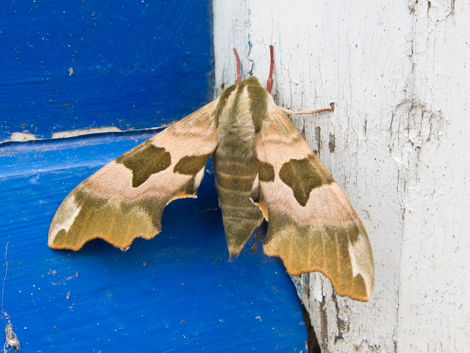 The Lime Hawk-moth (mimas tiliae) was our first visitor and stayed in the same spot for a couple of days. They apparently have a couple of colour forms – one being much more green than this one. Like many of the hawk moths they are quite common, but this is the first one that I have spotted. Just as with butterflies, moths tend to hang out in places that contain the food plant of their larvae. As the name suggests, Lime Hawkmoth larvae feed on limes, but also other deciduous trees such as birch, alder and elm.
The Lime Hawk-moth (mimas tiliae) was our first visitor and stayed in the same spot for a couple of days. They apparently have a couple of colour forms – one being much more green than this one. Like many of the hawk moths they are quite common, but this is the first one that I have spotted. Just as with butterflies, moths tend to hang out in places that contain the food plant of their larvae. As the name suggests, Lime Hawkmoth larvae feed on limes, but also other deciduous trees such as birch, alder and elm.
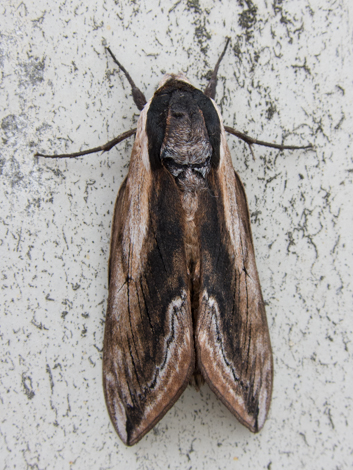 Next on the wall was a Privet Hawk-moth (sphinx ligustri) – a really big moth (the largest UK moth) – the wingspan can be up to 12cm across. This is a quite distinctive moth whose larvae feed on, yes, you’ve guessed it, privet, but also lilac and ash. Although these are also apparently fairly common I feel quite lucky to have seen it as they are only on the wing for a short time during July and August. Although this moth is pretty spectacular, the caterpillars are apparently even more impressive – no photos yet as I haven’t been able to find one.
Next on the wall was a Privet Hawk-moth (sphinx ligustri) – a really big moth (the largest UK moth) – the wingspan can be up to 12cm across. This is a quite distinctive moth whose larvae feed on, yes, you’ve guessed it, privet, but also lilac and ash. Although these are also apparently fairly common I feel quite lucky to have seen it as they are only on the wing for a short time during July and August. Although this moth is pretty spectacular, the caterpillars are apparently even more impressive – no photos yet as I haven’t been able to find one.
The final hawkmoth to make an appearance turned up today and even stayed for the day despite the rain trying to batter it into submission. This is the Poplar Hawk-moth (loathoe populi) a smaller moth than the previous two, but still pretty impressive. It is one of the commonest hawk-moths in the uk; the larvae feeding on poplar, willow and aspen.
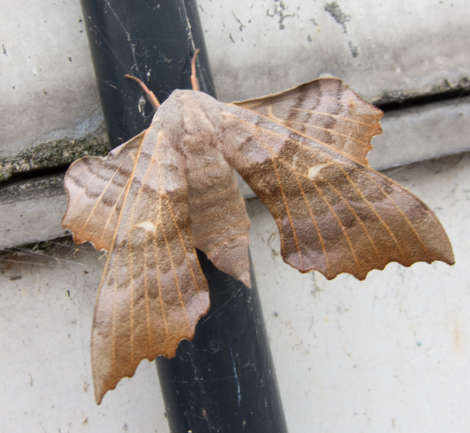 Although these moths are all hawk-moths they interestingly all seem to sit with their wings in different positions – the lime has them slightly outstretched, the privet had them held straight back and the poplar holds the back wings in front of the forewings.
Although these moths are all hawk-moths they interestingly all seem to sit with their wings in different positions – the lime has them slightly outstretched, the privet had them held straight back and the poplar holds the back wings in front of the forewings.
I’ve now started looking for moths and will keep an update on the wildlife that I find at work – once you start looking it is amazing what you can find, even in a town centre location. It is making me think that maybe I should start measuring the biodiversity of the site …
